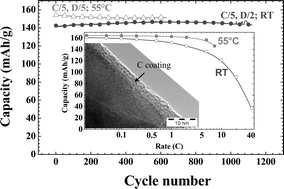Various strategies to tune the ionic/electronic properties of electrode materials†
Abstract
This Perspective highlights, through several snapshot examples, the importance of electrochemically-driven redox reactions in tuning the electronic/ionic as well as magnetic properties of 3d-metal-based inorganic compounds through a careful control of the metal oxidation state. Although such redox reactions usually imply the electron-ionic duality, they can be extended to insulating compounds (LiFePO4) or semiconductors (CoO) as long as we can combine electrochemistry at the nanoscale to reduce diffusion and migration limitations, and provide the compounds with electrons through metallic coating techniques. A thorough investigation of the composition–structure–property relationships of the LixCoO2 system, through the assembly of LiCoO2/Li electrochemical cells has led to the identification of the CoO2 phase, whose property and stability are discussed in terms of cationic–anionic redox competition, thus bearing some similarity with the high Tc cuprate superconductors. Such a d–sp redox competition could have structural and electronic consequences. Encouraged by the recently reported superconductivity in NaxCoO2;yH2O phase, the room temperature LixCuO2 phase diagram was reinvestigated through Li-driven electrochemical reactions. A solid solution domain was unravelled but superconductivity was not evident. With Cu-based materials such as Cu2.33V4O11, we have shown the feasibility of a new reversible Li electrochemically-driven copper extrusion/insertion process, owing to the enhanced copper diffusion within the structure.


 Please wait while we load your content...
Please wait while we load your content...